Protective Void Space: The most critical function that coral colonies provide to fish is void space. A void space is an area that protects fish from larger predators and provides shelter from energy draining water currents. Void space is created by coral colonies both in the interior of the structures, in holes and cavities of the eroded limestone, and areas around the reef where eddies and back currents form. During low current conditions, the void space expands to the largest distance a particular fish can be away from the reef and return for safe haven when its particular predators abound. Therefore, note that void space is different for different fish types and sizes. Void space shrinks during storm events and high currents. At these times the space is limited to interior cavities and close to the edges of more solid reef structures capable of creating an eddy. Rehabilitation of void space IS CRITICAL to restoring fishery resources to coral reefs and is often overlooked. Note: All reefs provides protective void space. Several living non-reef communities do so too, such as sea grass beds, kelp forests, submerged mangrove roots, floating sargassum "rafts or mats" or other floating biological masses; and even such surprising things such as whales, manta rays and sharks.
Rapid Response Training: Local training for dealing with coral damage events BEFORE an emergency occurs. Rapid response training is usually given along with the stocking of a Coral Disaster Response Kit. Having rapid response training means there is local talent available to deal with coral damage events, without having to rely on international assistance from a Coral Team activation. Since all non-perishable rehabilitation tools and supplies are pre-stocked before a disaster, this means there are no delays in dealing with coral damage and typically the disaster nursery step can be eliminated, thereby improving the odds of a successful rehabilitation.
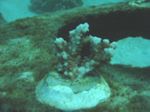
Rapid Tissue Necrosis (RTN): A rapidly spreading bacterial infection distinguishable by a very distinctive smell, fast movement of white tissue across the colony and rapid colony death, usually hours. RTN can occur at any site of injury to the coral. It starts as an area of white coral tissue, usually at the site of fragmentation or when the coral has been injured by handling RTN typically kills the entire fragment within 24 hours. RTN is one of the main reasons that transplanting whole colonies of coral is so difficult, because once started it will almost always kill the entire colony. The cause of RTN is a simple formula: STRESS+INJURY+BACTERIA=RTN.
Prevention is the only treatment for RTN. There is no cure for RTN and once identified in a fragment, the fragment should be destroyed and anyone handling the fragment must thoroughly wash their hands and disinfect any tools with alcohol or other sterilization measures, because RTN is extremely infectious, especially to stressed or injured coral. RTN is common in Acropora and other rapidly growing coral species, occasional in medium growth rate coral species and rare in slow growing skeleton coral species. It is fortunate that RTN rarely infects the very slow growing brain coral, so restabilizing adult brain colonies of brain coral can be quite successful even if the colonies are injured slightly in the effort. RTN has not been documented in soft coral species. However, soft coral species can succumb to bacterial diseases that result in death, just slower (usually taking 1-3 weeks to completely kill a plug). It is presumed that RTN can be caused by a number of different bacteria that are common in the marine environment. It can best be understood by considering RTN as an infected wound, just as an untreated cut can infect a human. Remember that coral are animals and are susceptible to the same kinds of infections that affect all animals.
RTN Prevention Strategies: We know the formula for RTN is STRESS+INJURY+BACTERIA=RTN Therefore, effectively dealing with RTN involves utilizing techniques to reduce injury and stress to the corals, antiseptic treatment of injury sites and good hygiene by those handling the coral. In terms of stress levels, this manual is full of tips such as gradual changes in temperature, light and water quality conditions. Handling practices such as ensuring polyps are contracted before contact is important. All transport procedures should insure that different coral species don't come in contact with each other and are not exposed to additional injury. Corals are ideally exposed to air only one time during the entire propagation and transplantation procedures. Every exposure to air reducs the amount of protective slime that protects the coral from infection. People in direct contact with coral (or water that coral is kept in) should only use oil free suntan lotion. Dissolved oxygen levels should be maintained at the highest possible levels and never allowed to drop below 4.5 mg/l. These strategies not only reduce the occurrence of RTN but also will create stronger coral fragments that are more resistant to coral predation.
Reef: Hard substrate with its associated fouling community that provides essential protective void space for fish and other mobile marine life.

Refractometer: A refractometer is a more sophisticated way than specific gravity meters (hydrometers) to measure the exact salinity or the amount of salt dissolved in seawater. They don't produce variable readings in different water temperature ranges either. Refractometers are available from professional environmental monitoring suppliers. They can be used to check the salinity of the Antiseptic dip if you are not using veterinary strength iodine solutions. They can also be useful if you are working where freshwater runoff can affect the conditions at your nurseries or coral propagation table. A refractometer is very useful for Red Mangrove projects because salinity must be closely monitored. Simply put a drop on the lens of the water you want to sample and look into the scope for the reading. Note: Must be calibrated with distilled water before use.
Release of Liability & Consent to Share Photos and Image Form: All Coral Team members must sign a release of all liability noting they are accepting full risk for participation in projects. This is critical because many government-based projects do not allow diving activities without special certifications due to liability. Additionally, members must agree that we can use their likeness or image in our publications, website, etc. Also, the team members must agree that they will share all project-related photos (not personal photos) with the Reef Ball Foundation and allow their unrestricted use.
Re-stabilization: Reattaching an adult coral colony back to the sea floor or an artificial reef module after it has been dislodged. Typically, this is accomplished using the Hydrostatic Method or some other anchoring method. Restabilization be as simple as uprighting a coral head that has been overturned.
RTN: See Rapid Tissue Necrosis
RTN Nursery: A temporary holding area for Acropora plugs (the coral most prone to RTN development), for a 24-48 hour quarantine period before planting on Reef Balls, in order to identify fragments that have succumbed to Rapid Tissue Necrosis (RTN) from fragmentation and plugging stress. This helps to eliminate planting plugs that will not survive, and avoids a 48 hour monitoring period with screwdriver and hammer in hand to remove bad plugs following transplanting. A 5-10% loss of Acropora plugs is typical, unless conditions are perfectly managed and therefore slightly more plugs should be made than are desired.
Runner: In some situations, a "runner" is a diver or snorkeler that transports full coral plug trays from the coral propagation table to planting teams and returns with empty trays to the coral propagation table. In other situations, planting teams do their own running). Divers with aerobic sport training are ideal candidates for this task.
Runner's Socks:Due to the high incidence of blisters on the feet when working in sandy areas, RBF Coral Team members are sometimes required to wear double-layered socks (when dive booties are not used) to prevent blisters. These are commonly available to runners with a common brand named "Wright Sock." You can also obtain lycra socks from a company called "Scuba Doo" but two pairs will need to be worn for the best protection. http://www.cococheznaynay.com/ is the Scuba Doo website. They also produce a Reef Ball "Doo Rag", a popular item among team members to shield their heads from sunburn. When dive booties are worn, only one layer of socks are required to reduce blistering.


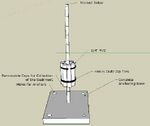
Sand Analysis: In some projects, you may need to learn about the grain size distribution, sand composition, or amount of sand transporting through your site as part of your rehabilitation efforts. For example, sand sieve analysis can be performed to see what size grains are present. This is useful for erosion control issues and coral sediment stresses (corals are more stressed by smaller grain sizes). One can obtain standard screens for this analysis at forestry suppliers or similar vendors. Take your sand samples from multiple locations (if an erosion control project as instructed by your coastal engineer) and place in marked zip lock bags. When you return to your lab, dry the sand (a microwave works nicely) and put on a paper plate. Split the sand into four even quadrants and use sand from two opposing quadrants for passing through the sieve screens. You can then compute percentages of various grain sizes on the basis of volume, weight or both.
Sometimes you will want to know more about the composition of the sand. Take a small sample and view with a magnifying lens. Sorry, this is slow work. It can be useful to understand the type of sediment stressing the corals. Generally terrestrial-based (round sand grains) are more stressful to corals than irregular shaped coral or shell sands.
Finally, and usually most importantly, you need to know how much sediment is traveling at a particular water depth in your site. It is VERY important to know what height particular coral species must be planted above the sea floor to avoid sedimentation stress. A simple sediment trap can be made following the diagram below (available in Sketch-up). This trap can be used in the natural reef to determine what level of sediment a particular coral can handle and then be applied to your planting strategy. The length of time the trap must be in place depends on the volume of sediment in the area. What is important that the time frame is the same in all your locations so that sediment volumes or weights are comparable. Note the design allows for adjustable heights and easy retrieval of the sediment trap collection tubes.
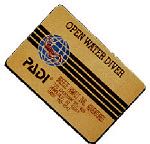
SCUBA Certification Card: Nearly all Coral Team members are SCUBA certified. Coral Team members must send an electronic scan of their certification cards to the Reef Ball Foundation before they can participate on Reef Ball Coral Teams. Team Leaders make assignments based on your highest level of certification plus your demonstration of scuba skills in the field. Note: we also recommend that you keep an electronic copy of your passports on file with us in case you lose your passport on a trip. Sea Surface Temperature (SST): SSTs are used to help predict bleaching events and to help determine temperature ranges on a reef. Remember, SST is a surrogate for reef water temperature, but they are not always the same due to thermoclines.
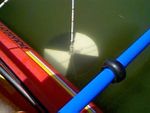
Secchi Disk: An 8 inch disk with alternating black and white quadrants used to determine the degree of underwater visibility. Markings or knots on the rope identify the distance of the disk from the water surface. The disk is lowered into the water until it disappears and the depth recorded, then the disk is raised until it re- appears and the depth recorded. The two depths are averaged and this becomes the Secchi visibility. Usually, the color of the water is also noted. Sediment Grain Size Analysis: See Sand Analysis
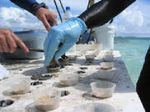
Setting: The art of laying a coral fragment in the medicine cup mold after it is filled with fast setting plug cement. It is an art because there are several factors that must be considered including a "top" and "bottom" side to many coral species such as Elkhorn and Lettuce coral. Sideways orientation is required for finger corals to stimulate better basing. Knowing just how deep the coral needs to be placed into the plug cement for proper adhesion is an important skill. Some coral species, such as soft coral with woody stems (gorgonians) require exact depth placement with the flesh only touching, but not below the concrete surface. During "setting" the dry hand dipper and setter must judge the concrete setting time exactly and not place a coral during or after flashing. Some species require special "setting" techniques such as having some part of the coral braced against the side of the medicine cup mold. Medicine cup mold modification may be required for larger fragments, ask your coral team leader about this if required. Sterilized Hard Bottom: Areas of freshly exposed limestone rock typically from a ship grounding, tsunami, hurricane or other physical event. This type of bottom can be drilled to create coral adapter receptacle holes and subsequently used for coral planting. Freshly exposed sterile bottom from sand movement is not recommended because the sand can return and smother the planted corals. Note: Without the addition of artificial reefs, it will take much longer for these planted reefs to develop the complexity of a mature reef. However, this approach is often suited for organizations that prefer not to use artificial reefs.
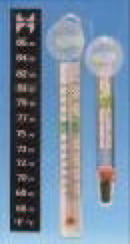
Submersible Thermometer: A thermometer is used to check the temperature of the antiseptic dip and to check the nurseries and coral table plug curing areas. The thermometer is also used to take ambient water temperatures to make sure temperatures don't exceed 30 degrees Centigrade (86 degrees Fahrenheit); which is the temperature when fragmentation and plugging activities need to be stopped. These activities can be continued if a Dissolved Oxygen test can be conducted to confirm that DO levels are over 4.5 mg/l (in which case it is possible to continue fragging and plugging). If a DO test kit is not available, a rule of thumb is that if it is windy and there is good circulation it will probably be okay, if it is calm or poor circulation it is likely dangerous to proceed. In fact, on calm days or in low circulation environments DO testing should begin at 28 degrees Centigrade or 81 degrees Fahrenheit.
Subsidence: A term used to describe an artificial reef or base substrate sinking into a soft sea bottom type (typically sand or mud).
Sugar: Sugar acts to slow down (retard) the setting speed of cement and it can be used in when the fast setting plug cement flashes too quickly. Sugar water is used on concrete artificial reef molds to create a rough surface texture with exposed aggregates that encourages natural settlement of larval coral (the module surface must be rinsed with water immediately after de-molding to achieve this effect).
Sunburning: Coral can suffer ill effects of the both the sun's UV rays and changes to higher intensity lighting conditions similar to moving a house plant directly into full sun. Moving corals into shallower water, clearer water, changing compass orientation to a more south (north in southern hemisphere) facing orientation and moving to less shaded areas can all cause sunburn.
Supply Stocker: The person on the Coral Team designated to bring fresh supplies to the coral table including fresh water, moist sand, plug cement, etc. Often, the supply stocker will help ready planting teams, inventory material stocks, serve as a safety guard, arrange for snacks, meals or hydration, and make store runs for special needs. This position can be filled by a non-diving member of a Coral Team and is critical to overall efficiency. If the team has vehicles, the Supply Stocker is normally in charge of their use and allocation.
Underwater Epoxy Putty: See Epoxy Putty
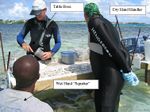
Table Boss, Boss or Mixer: The person at the coral propagation table who handles mixing and pouring of the 3 minute setting concrete, cleaning of the mixing vessels and who gives directional commands to the other table workers. The Table Boss controls the pace of production and is responsible for quality control and safety.
Thermoclines: Thermoclines or "temperature layers" are distinct horizontal layers in the sea with temperature differences usually getting cooler with each layer passed (if there are multiple thermoclines) on the way to the bottom. Sometimes these temperature changes are very substantial. For coral teams, care should be taken not to bring coral through thermoclines if possible…the temperature shock creates a lot of stress on coral. Additionally, if SST is used to determine reef water temperature, it should be adjusted if a thermocline is present. A reverse themocline is when the temperature on the bottom is warmer than the temperature on the surface. As seen in the graphic to the right, they can manifest in several complicated forms.
Transplanting: The act of moving a whole coral colony from one location to another location. This is much more difficult than propagation and planting fragment plugs. It requires a special level of certification on the Coral Team and should be considered a useful technique only for high value corals that cannot be easily propagated.
Waterproof Papers and Field Books: Coral Team participants often need waterproof paper for underwater monitoring forms and field books for recording data. You will find these and other specialty field items like sand grain distribution sorters, refractometers, and survey equipment at http://www.forestry-suppliers.com/
Warfare or Coral Warfare, Chemical Warfare: Some species of hard coral (most famously Galaxia species) have the ability to sting nearby coral to defend or create new territory for themselves. Being closely related to jellyfish, this is not surprising. Galaxia and other species have specialized stinging tentacles that can sometimes reach long distances (a foot or more). Other species have toxins in their slime coats which can affect their enemies. This is one of the reasons why hands must be washed between handling of different species to avoid (the other reason being sanitation) spreading loose tentacles or slime from one coral species to another. The other implication is that hard corals must also be separated when handled in captivity. With expertise, one can learn that not all coral have this ability and it is "okay" to mix certain species, but it is better to err on the side of caution and avoid this practice. Soft corals are not known to have this ability.
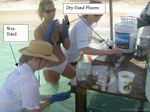
"Wet Hands Table Worker: The person at the coral propagation table who handles wet fragmented coral and the plug curing process.
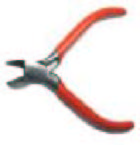
Wire (Diagonal) Cutters: A tool used for fragging, typically for small finger coral species.

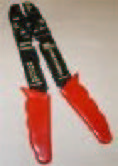
Wire Strippers: A tool used during the fragging process for woody-stemmed soft coral (gorgonians). This tool is used to strip back the flesh at the base of a propagated stem, exposing enough of the woody stem to be embedded in the plug for a firm attachment. Care must be taken to hold the gorgonians softly so that there is no crush injury from your grip on the coral. Automatic wire strippers can be used on some soft coral types to avoid crush injury. Zip Tie Method: A method of attaching small to medium diameter coral fragments directly to a base substrate or temporary nursery with plastic zip ties. Zip tie methods are generally suitable for larger fragments of basing coral species on stable substrates with small diameter attachment points. The technique is most useful when there is an over-abundance of imperiled finger type corals after storms. This method is often used in coral farming and temporary attachment situations. Variations of this technique include attachment with fishing line, rope, metal wire, etc, ... For temporary nursery uses, with gorgonians, the woody stem must be exposed using a wire stripper and the zip tie should be attached to the woody part only. Zip ties should be fully tightened for either soft or hard corals, even in nursery situations.
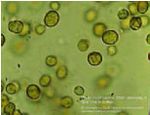
Zooxanthellae: According to NOAA, "Most reef-building coral contain photosynthetic algae, called zooxanthellae that live in their tissues. The coral and algae have a mutualistic relationship. The coral provides the algae with a protected environment and compounds they need for photosynthesis. In return, the algae produce oxygen and help the coral to remove wastes. Most importantly, zooxanthellae supply the coral with glucose, glycerol, and amino acids, which are the products of photosynthesis." In regard to planting coral, the light requirements of the zooxanthellae must be satisfied and rapid changes in light intensity levels can shock or kill zooxanthellae. Additionally, if a coral is stressed by high temperatures and low dissolved oxygen levels, they can expel zooxanthellae from their body which is called "bleaching" and if the bleached condition lasts long enough the coral will die.
Planting Team: A dive team that mixes underwater epoxy putty and plants coral plugs onto substrate modules. Sometimes divers work in teams of two, with a mixer and a planter and sometimes each member does both tasks. In many cases, planting teams do not wear fins when planting to avoid accidentally knocking off adjacent, freshly planted coral plugs. Even in shallow water, dive tanks should be used to ensure careful slow movements needed to plant coral without disturbing other freshly planted plugs. The diver can use the tray to store supplies such as a wire brush, or extra epoxy putty. Planting teams need to be trained on the project's planting strategy to know where to plant coral plugs with specific coral species. Planting errors can take years to show up and avoiding them can be important for long-term success. A veteran planter in good sea conditions can plant 100 or more coral plugs per hour, but variable conditions such as current, surge, or reduced visibility can reduce this number drastically. An experienced and skilled planter uses much less epoxy putty per coral plug than a newly trained beginning planter. A beginning planter may get 5-7 plugs per epoxy stick, whereas a skilled planter can get 20 or more. When computing the amount of epoxy putty needed for a project, take this variable into account.
Planting Strategy: A planting strategy must be developed to allow the base materials to develop as closely as possible to the species diversity and population densities of nearby natural reef. Mastering the development of planting strategy takes a level of skill that is beyond most volunteer teams. Typically, the Foundation develops a planting strategy using RBF experts, who are assisted by as much local expertise as can be accessed. Todd Barber, John Walch, Lorna Slade, Marsha Pardee and Mario van der Bulck are currently (2006) the RBF experts that have the level of understanding needed to develop good planting strategies. There are probably some coral rehabilitation specialists/scientists that have similar skills, particularly ones that know specific local environments well. We also hope to develop more experts, but this type of training takes years, not months. Some of the complex factors that go into planting strategy are:
- Environmental tolerances of the particular species (lighting, currents,
sedimentation resistance, salinity, temperature changes, feeding requirements, depth limitation, etc.)
- Warfare or fusing of coral colonies
- Expected growth rates of various species
- Expected natural settlement on the artificial reefs
- Water quality, present and expected
- Wave and climate expectations
- Goals of the individual project (for example aesthetics, specific use, etc.)
- Capabilities of the project (how many coral can be planted, etc.)
- Preferences for threatened or endangered species
Plating /Encrusting Coral: Coral that bases but does so in an unlimited fashion typically growing over hard surfaces that are not already colonized by other coral.
Reef Building Coral: substantial calcium carbonate depositing (hard) coral. The environmental assessment found, for example, mustard hill variety, Porites astreoides, Lesser Starlet Coral, Siderastrea radians, Massive Starlet Coral, Siderastrea siderea, and Boulder Star Coral otherwise referred to as Montastrea annularis that are reef-building corals.
Non-Reef Building Coral such as soft coral. Most notably Pterogorgia guadalupensis (Purple grooved-blade sea whip) and a few common sea fans on the site.
Mobile Inhabitants: animals, reptiles, fish, invertebrates and other marine life capable of moving when threatened.
Change Tolerant/Hardy Coral: generally slow growing hard coral such as brains or coral that handle cold, changing or turbid conditions well such as Porites porites (finger coral) or pencil coral. These coral can often be handled with less care and will generally survive well.
Sensitive Coral: generally the fastest growing hard coral such as Acropora species that is very susceptible to coral diseases/damage caused by handling such as rapid tissue necrosis. Also includes (attached) coral heads or other complex communities where damage and loss are common with improper handling.
Basing Coral: coral that will re-attach to base substrate creating a limited base size when replanted. (And can be attached temporarily by a re-planter as long as the attachment will hold until the coral is rebased).
Plating/Encrusting Coral: coral that bases but does so in an unlimited fashion typically growing over hard surfaces that are not already colonized by other coral.
Non-Basing Coral: coral that cannot re-attach to substrate when re-planted. (And therefore must be attached permanently by the re-planter).
Asexually Reproducible Coral: coral that can be (easily) reproduced asexually (Typically coral that are easy to divide).
Not Asexually Reproducible Coral: coral that cannot be reproduced asexually (easily). (Such as individual polyp coral or coral that require advanced techniques such as coring to be propagated).
Coral sizes include:
- Coral Heads: coral colonies that are typically well attached to the seabed and are typically a mixed community of coral species and a benthic fouling community. A coral head it typically defined by a perimeter of sand/seagrass/mud and/or live bottom.
- Individual Coral Colonies & Live Rocks: Individual coral colonies or loose rocky substrate with a fouling community that are not well attached, often small, and if coral are usually of a single coral species type. If coral, they are generally too small to have a substantial associated fouling community.
- (Coral) Fragments: broken or intentionally segmented pieces of a coral colony normally used for asexual reproduction of a coral colony.
Disclaimer[edit | edit source]
This information was Reef Ball's Draftguide document.